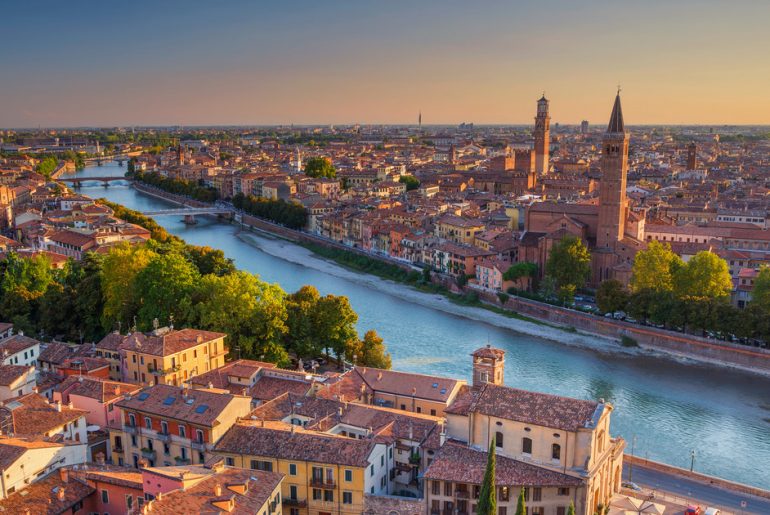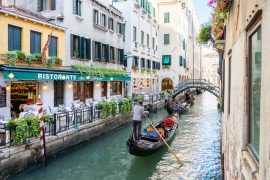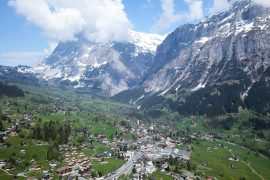Its attractive location on the Adige River surrounded by the Venetian Alps, as well as its rich history dating back more than 2,000 years, make Verona one of the most magical and unique places in Italy. It is not without reason that every year the city of lovers is visited by hundreds of thousands of tourists.
Description of the city
Tourists love Verona because love is present in every corner of the city. For how to write about the city of lovers without mentioning the tragic scenario of Romeo and Juliet's romance? It cannot be denied that it was Shakespeare's drama that brought fortune to Verona - a significant part of the economy is based on "romantic tourism". Crowds gather under the famous balcony every day. Everyone wants to touch the statue of Juliet located in the courtyard - it is supposed to bring good luck in matters of the heart. Few people realize, however, that the statue of the heroine of Shakespeare's drama is a replica, and that the famous balcony, under which about two million tourists gather annually, was added. However, it should be remembered that Verona has much more to offer than the romantic story of a pair of unhappy lovers. So let's think about how to get to Verona, discover its most special places, and stop for a while in one of the local restaurants to feel the true spirit of the city of love.
What to see. Attractions and sights
It is no coincidence that the city of Shakespeare's drama is called by Italians the "Porta d'Italia," or "Gateway to Italy." Verona's historic center is a UNESCO World Heritage Site. Located on the picturesque Adige River, the city impresses with its architecture, in which Roman, medieval, and Renaissance traces are noticeable. One thing is certain - in Verona we will certainly not be bored.
Arena di Verona - the Roman amphitheater in Verona
The Arena in Verona is a Roman amphitheater built in the first century AD, and is a symbol of the city. It once hosted gladiatorial fights. It is the third largest (after the Colosseum and Capua Amphitheater) Roman amphitheater, capable of holding as many as 20,000 spectators. Today it attracts tourists not only for its beauty and history, but also for the cultural events held there. Every summer during the Opera Festival, the Arena di Verona transforms into the largest open-air opera house in the world.
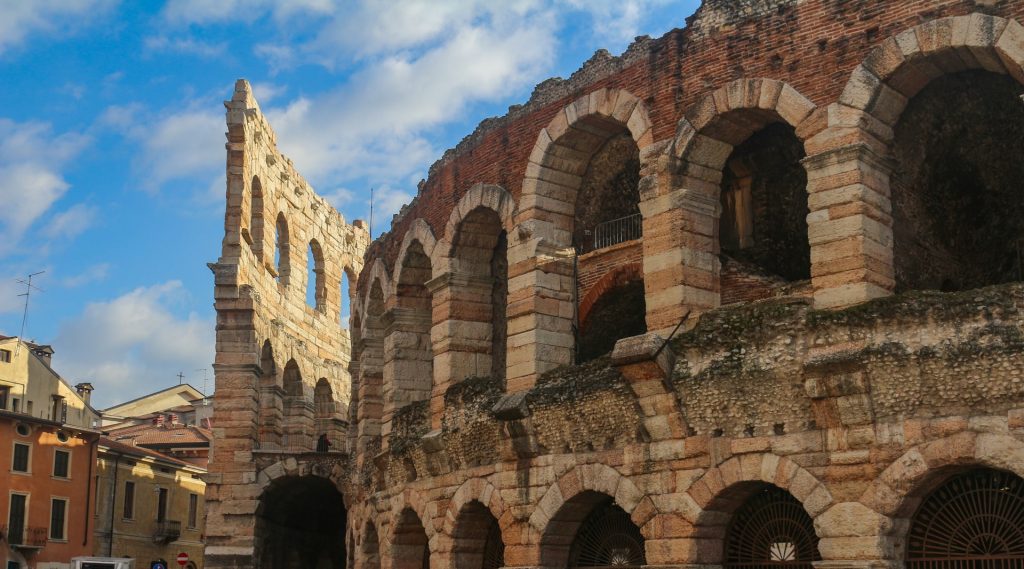
Piazza delle Erbe
Built on the plan of an ancient Roman forum, Piazza della Erbe is described in guidebooks as one of the most beautiful squares in Italy. The place is a truly unique blend of styles, history and smells. Particularly noteworthy are the buildings surrounding the square, such as the Palazzo della Ragione, Case Mazzanti and Casa dei Mercanti. The oldest feature in the square is a fountain topped by a statue of the Madonna from the Roman period. Also noteworthy is an ancient column called "Tribuna," from which the city government once spoke. In the central part of the square there are many stalls selling souvenirs and local delicacies.
Torre dei Lamberti - viewpoint on the tower
Looking up at the sky near Piazza delle Erbe, it's hard to miss the 84-meter Torre dei Lamberti tower - one of Verona's most interesting vantage points. Construction of the tower began in the 12th century, but in the 15th century its upper part was destroyed by a lightning strike. Restoration work did not begin until 45 years later. This explains the mix of materials used in its construction - the lower part of the tower is made of tuff, while the higher part is made of brick. In the 18th century, a clock was installed on the tower, which can still be admired today. It takes a bit of effort to reach the top, but after climbing 368 steps you will be rewarded with a truly spectacular view of the city.
Casa di Giulietta - Julia's house
In the heart of the historic old town of Verona, we can admire the house with the famous balcony, which is deceptively similar to the building described in Shakespeare's drama. However, it should not be forgotten that it is only a symbolic place. Probably the legend of Juliet's house was born from the coincidence of names - according to historians, the house from the 12th century belonged to the de Capello family, which resembles the name of the heroine of Shakespeare's drama - Juliet Capuleti. Verona authorities decided to capitalize on the building's legendary fame as early as 1907, buying it and turning it into a tourist attraction. Few people also realize that the balcony itself was not added until 1935. Although marble from a Venetian palace dating back to the 14th century was used in the construction, it doesn't change the fact that a simple balustrade was there before. Nevertheless, the spirit of the lovers from Shakespeare's masterpiece at Casa di Giulietta is alive as nowhere else. Passing through the gate to Shakespeare's childhood courtyard, one will see engraved on the wall, countless declarations of love, hearts and initials of lovers. The courtyard is also home to the famous statue of Juliet - legend has it that when you touch a woman's right breast, you will find true love. It was the tourists seeking happiness in love that contributed to the transfer of the original statue made in 1969 by sculptor Nereo Costantini to the museum. Due to the constant touching of the heroine's breasts, a small hole appeared on it. So, to avoid complete destruction of the statue, the statue was replaced with a replica in 2014.
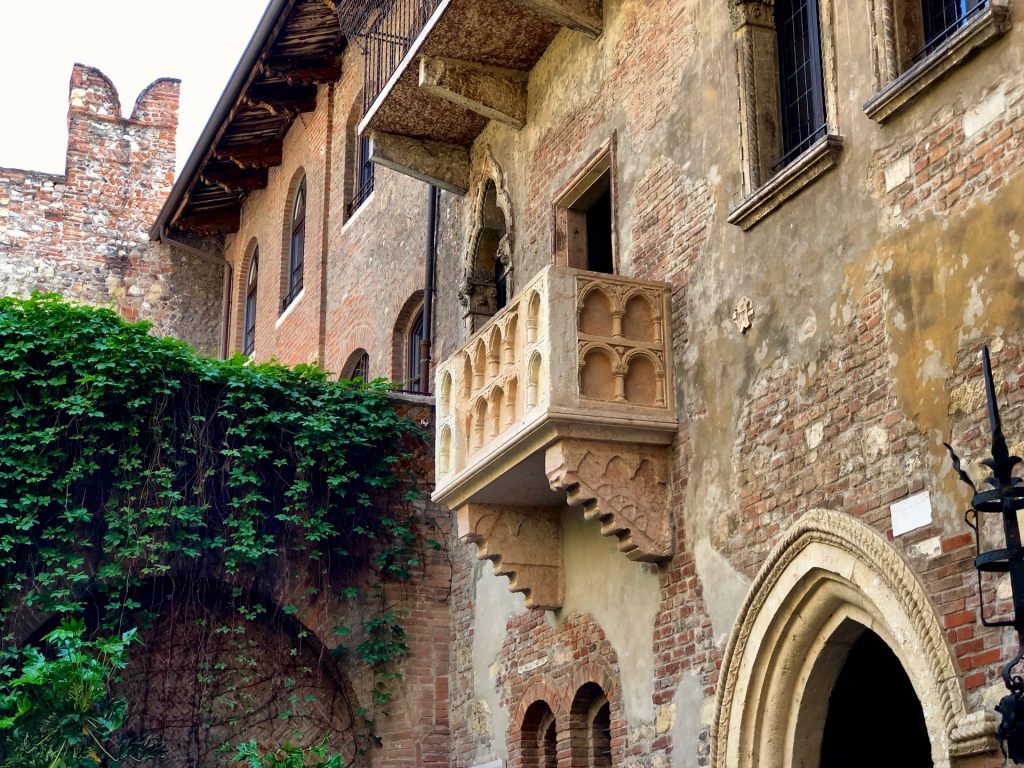
Tomba di Giulietta - Giulietta's tomb and the Fresco Museum
"Tomba di Giulietta" is the alleged burial place of Giulia Capulet, the heroine of Shakespeare's drama. The austere sarcophagus of red Veronese marble is located in the 13th-century monastery of the Capuchin friars, which has been turned into an art museum. As suicide was among the gravest of sins during the medieval period, the tomb, unmarked with a coat of arms and containing no information about the deceased, fits perfectly with the legend of Juliet's secret burial. The nearby museum also features, among other things, frescoes detached from Veronese palaces and churches dating from the 10th to 16th centuries.
Ponte Pietra - Stone Bridge
When visiting Verona, it is impossible to miss the Ponte Pietra, or literally "Stone Bridge." This is the oldest Roman bridge in Verona, some parts of which even remember ancient times. It was here that the first wooden bridge over the Adige River was built in 89 BC. Over time, the wooden structure was replaced by a stone one, but during its more than 2,000-year history the bridge was destroyed by floods several times. It suffered its worst damage in 1945, when it was blown up by German troops retreating from the city. In the 1950s the bridge was rebuilt using only original materials fished from the water.
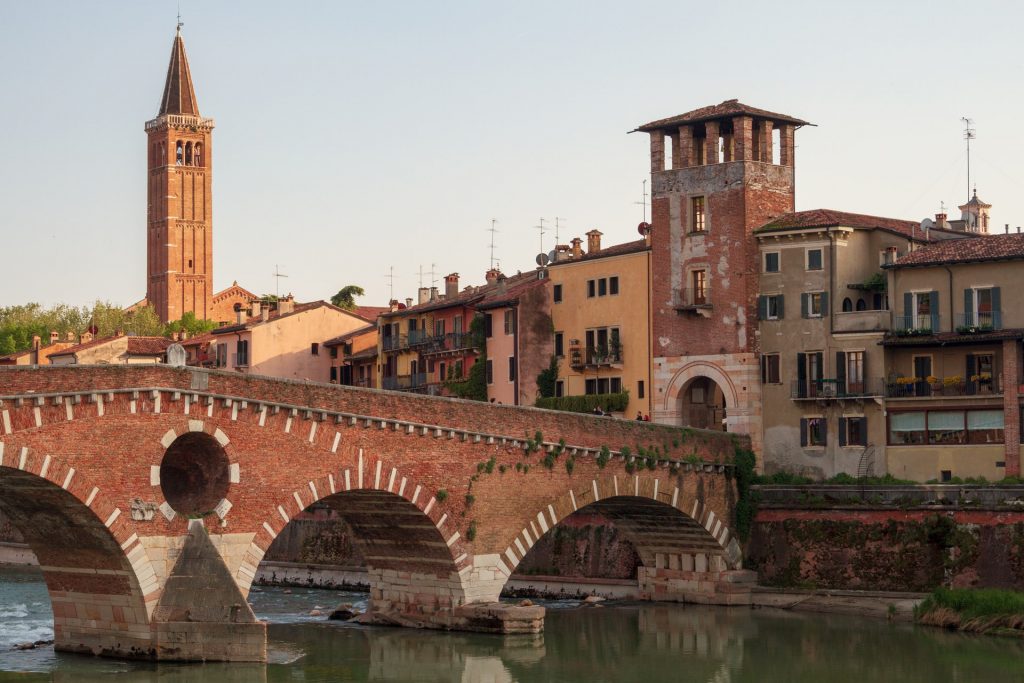
The terrace at Castel San Pietro - a vantage point
The terrace located at the Castel San Pietro, which rises on St. Peter's Hill, offers a spectacular view of the old city skyline. It's an ideal place for a walk - you can get to the top by taking the stairs, which are located just off the Ponte Pietra. There are about 230 steps to climb, and the ascent will take about 15 minutes. Alternatively, you can take the cable car, the lower station of which is located at Via Santo Stefano 6. This place holds a particularly important place not only in the hearts of tourists, but in the hearts of Verona residents themselves. The open space with a magical view of the old town is conducive to meetings and walks. It is definitely worth going there both during the day and at night.
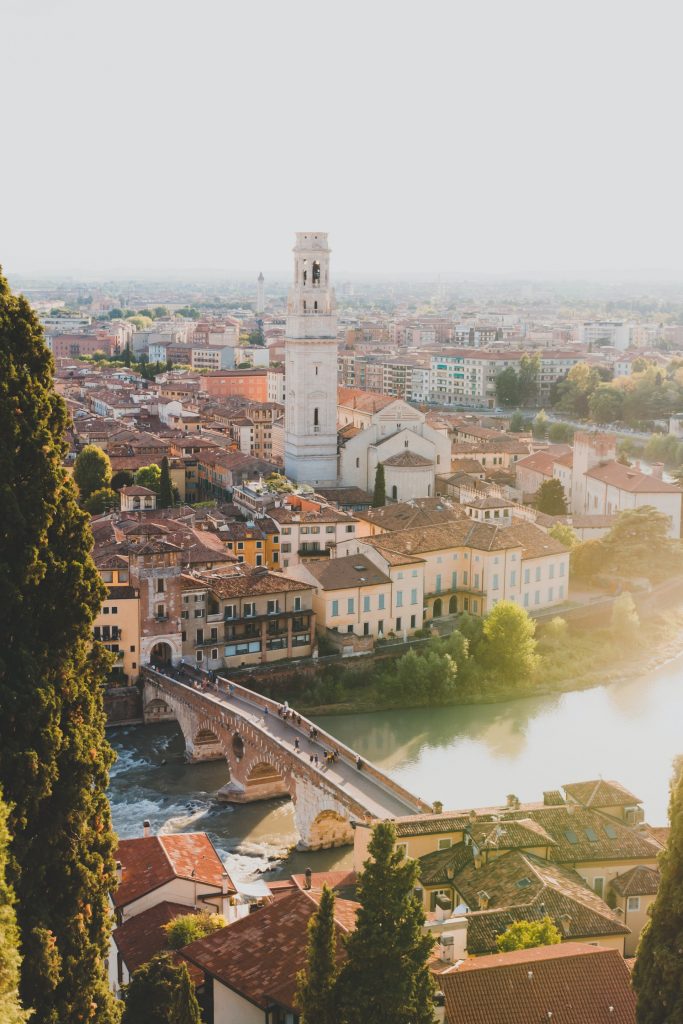
Ponte Scaligero - Bridge of the Scaligers
Built of typical red bricks of medieval Verona, the 120-meter-long Ponte Scaligero is described as Verona's most daring and admirable medieval work. It was built in just three years, most likely in the 13th century, by order of Verona's then ruler, Cangrande II della Scala. It was intended to secure an escape route to the north in the event of an attack on the Castelvecchio fortress. Like the Ponte Pietra, the bridge was destroyed during World War II, then rebuilt with materials fished from the river. From the bridge one will see a breathtaking view of the Adige River.
Castelvecchio Fortress - a medieval fort and museum
Castelvecchio is a medieval fort located in the historic center of Verona. Today, the fort houses a museum of the same name, which includes a medieval lapidarium. Many valuable artifacts can be seen there, including early medieval and Romanesque epigraphs, Veronese sculptures from the 14th and 15th centuries, free-standing frescoes, paintings from the Middle Ages and early Renaissance, and sculptures and jewels from the 14th century. The castle also has an exhibition of ancient weapons.
How to get to Verona?
Thanks to its central location in northern Italy and the presence of important road and rail networks, Verona is easily accessible from major European and Italian cities by various means of transportation: plane, train, or car. If you're planning a longer stay in Italy, it's worth adding that the city of lovers is also a great base for many nearby tourist destinations, such as Lake Garda, Milan, Venice, Bologna or Florence.
Plane
12 kilometers southwest of Verona's city center is one of the largest airports in the region Veneto - International airport "Aeroporto Valerio Catullo." The port serves more than 3.5 million passengers annually. From Poland we can get there with the low-cost airline WizzAir, departing from Warsaw. From Verona airport we can get to the center by Aeroporto bus, whose stop is right next to the airport terminal. The airport bus runs every 20 minutes or so during the day, with a travel time of just 15 minutes. It will take you to Verona Porta Nuova main train station for about €6.
Train
If you want to reach Verona by plane, and there are no flights available from Warsaw, it is also worth considering other options. Cheap flights to Milan, Venice or Bologna are available from many Polish cities at attractive prices. Getting to Verona from other cities will certainly not be a problem, we can easily get there by train. Verona is located at the intersection of the Milan-Venice (east-west) and Bologna-Brenner (north-south) rail lines. Trains run every hour or so. For visitors, it is most beneficial to get off at Verona Porta Nuova station, from where you can quickly reach the historic center - it will take about 20 minutes on foot. The center can also be easily reached by cab or public transport bus.
Car
Verona is a very easily accessible city for motorists as well. Located at the intersection of highways The A22 from Brenner (north-south) and the A4 from Serenissima (east-west), makes it easy to reach in a very short time. Highway exits on the A4 are Verona Est and Verona Sub, on the A22 Verona Nord. For visitors, the best option is to take the Verona Sud exit, from where you can directly reach the center.
Where to eat in Verona?
Italian cuisine needs no introduction to anyone. However, the local cuisine of the Veneto region is not only sun-ripened vegetables, freshly caught fish and seafood and regional pasta. It may come as a surprise that venison, beef and horse meat are often eaten in Verona. Among the desserts, on the other hand, the famous Verona babka "Pandoro Veronese" should not be overlooked. However, one thing is certain - the number of bars, taverns and restaurants is really impressive. We also have good information for wine lovers - the city of love is one of the largest wine-growing regions in Europe. So let's check out where to eat and drink wine in Verona.
Locanda 4 Cuochi
Locanda 4 Cuochi or "Inn of 4 Cooks" is an authentic place with unaffordable prices and great Italian food. It is located in the very center of Verona, a few steps from Piazza Bra. The extraordinary atmosphere here is built not only by the staff, but also by the guests - four pencils and pieces of paper are available on each table so that everyone can leave their mark on the restaurant. At "Locanda 4 Cuochi" the unparalleled gorgonzola is especially worth trying, as well as the gnocchi and ravioli. For dessert, delicious plum cake and unparalleled tiramisù are recommended.
Osteria Al Duca
The Osteria occupies the ground and second floors of a 13th-century-built townhouse that is believed to be the birthplace of Romeo from Shakespeare's drama. Adding to the atmosphere is the fact that the space where meals are now eaten was used as a horse stall in the past. The room was turned into an inn and resting place centuries ago, so that travelers could enjoy regional dishes here accompanied by polenta and good wine. It's an inn where you can eat authentic regional dishes, especially the typical Verona bigoli col musso (ragù d'asino), and drink local wine.
Osteria del Bugiardo
Osteria del Bugiardo is one of Verona's most popular taverns, ideal for a quick lunch, aperitivo or informal dinner. Even at first glance, it's clear that the place was created for the love of wine. The history of the establishment began when Alfredo Buglioni, an established textile entrepreneur, opened a vineyard in the village of Valpolicella. After building a wine cellar, he decided to take the next step and open a traditional tavern in the center of Verona, very warmly received especially by young people. The spirit of the place is described by a quote by Francesco Guccini, which can be read in front of the establishment: "When I die, bury me in the vineyard, so that I can give back to the earth all that I have drunk in my life."
Accommodation in Verona
Are you going to Verona? Check out the offer of accommodation and apartments in the center of Verona on booking:
Booking.com
